Choosing the right healthcare compliance software can be as challenging as achieving compliance itself. Between HIPAA regulations, OSHA requirements, and constant updates, staying compliant has become a full-time job, one that can no longer be managed with manual processes.
Spreadsheets, paper files, and scattered digital systems create gaps that auditors are trained to find. A single mistake can trigger penalties reaching six figures, not to mention the reputational damage that follows a compliance failure. The stakes are simply too high to rely on outdated tools.
Modern healthcare compliance software addresses this issue by automating the time-consuming tasks: tracking policy updates, managing staff training, recording risk assessments, and maintaining audit-ready records in a single platform. Whether you’re running a small office or an extensive health system, the right compliance software changes the job of meeting government rules from a steady worry into an orderly process.
This guide examines the top 11 healthcare compliance platforms, breaking down their unique strengths to help you identify the solution that best suits your organization’s specific needs.
Top Healthcare Compliance Software at a Glance
| Software | Best for | HealthcareFocused | HIPAA Training | Mobile App | Pricing Model | Free Demo |
| ComplyAssistant | Healthcare-specific Governance, Risk & Compliance | ✓ | ✓ | ✓ | Subscription plans | ✓ |
| HealthStream (ComplyQ / SafetyQ) | Workforce training | ✓ | ✓ | ✓ | Subscription plans | ✓ |
| SafetyCulture | Frontline operational compliance & audits | ✓ | ✓ | ✓ | Subscription plans | ✓ |
| Sprinto | Cloud-based healthcare organizations | X | X | X | Custom quotes | ✓ |
| ATLAS Systems (PRIME®) | Supporting large, highly complex networks | ✓ | ✓ | ✓ | Custom quotes | ✓ |
| MedTrainer | Bundling compliance, credentialing, and learning management | ✓ | ✓ | ✓ | Custom quotes | ✓ |
| FlowForma | Automating complex processes with a no-code platform | X | X | ✓ | Subscription plans | ✓ |
| Compliancy Group | HIPAA Compliance Simplification | ✓ | ✓ | ✓ | Subscription plans | ✓ |
| VComply | Policy management | ✓ | X | ✓ | Subscription plans | ✓ |
| Healthicity | Healthcare Audits | ✓ | ✓ | ✓ | Subscription plans | ✓ |
| Healthcare Compliance Pros | Managing multiple practices from one central location | ✓ | ✓ | X | Custom quotes | ✓ |
1. ComplyAssistant – Best for Healthcare-specific Governance, Risk & Compliance
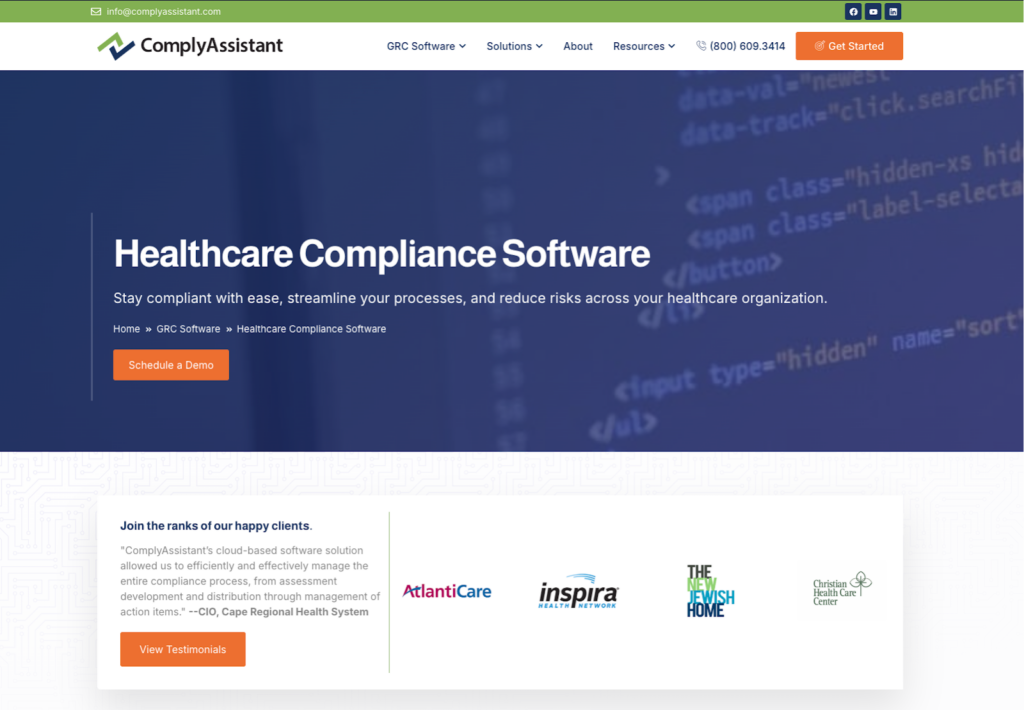
ComplyAssistant isn’t a generic tool adapted for healthcare. It was built from the ground up as a healthcare-specific Governance, Risk, and Compliance (GRC) platform. It has been proven to simplify HIPAA compliance by providing a structured yet flexible framework to manage the entire compliance lifecycle. This includes everything from risk assessments and policy management to vendor oversight and incident tracking. The software is designed to scale, making it a powerful fit for mid-sized to large healthcare systems, hospitals, long-term care facilities, mental health facilities, physician practices, and organizations that need to manage complex, multi-facility compliance programs with precision and accuracy.
Key Features
- Centralized policy and document management with version control
- Comprehensive risk assessment and internal audit tools
- Advanced vendor and third-party risk management module
- Incident reporting and corrective action tracking
- Direct support for HIPAA, HITRUST, NIST, and other key frameworks.
- White-labeling options for consulting firms
Pros and Cons
| Pros | Cons |
| Deeply customized to the needs of healthcare organizations | May be more comprehensive than needed for very small practices. |
| Strong vendor risk management capabilities | Consulting services are available for assistance |
| Highly flexible and scalable, suitable for a wide range of healthcare settings |
Client Testimonial
A ComplyAssistant user, Chief Information Officer at Cape Regional Health Systems, shared on the Featured Customers platform:
“Cape Regional Health System engaged ComplyAssistant’s software solution and professional services team to administer HIPAA Security assessments to our high-risk business associates (BA). Their cloud-based solution allowed us to efficiently and effectively manage the entire process, from assessment development and distribution through management of action items”.
Why Choose This Software
ComplyAssistant is optimal for organizations that need a purpose-built GRC platform. Choose this software if you need an enterprise-grade, healthcare-native GRC platform that offers depth, flexibility, and powerful risk management tools out of the box.
2. HealthStream – Best for Workforce Training
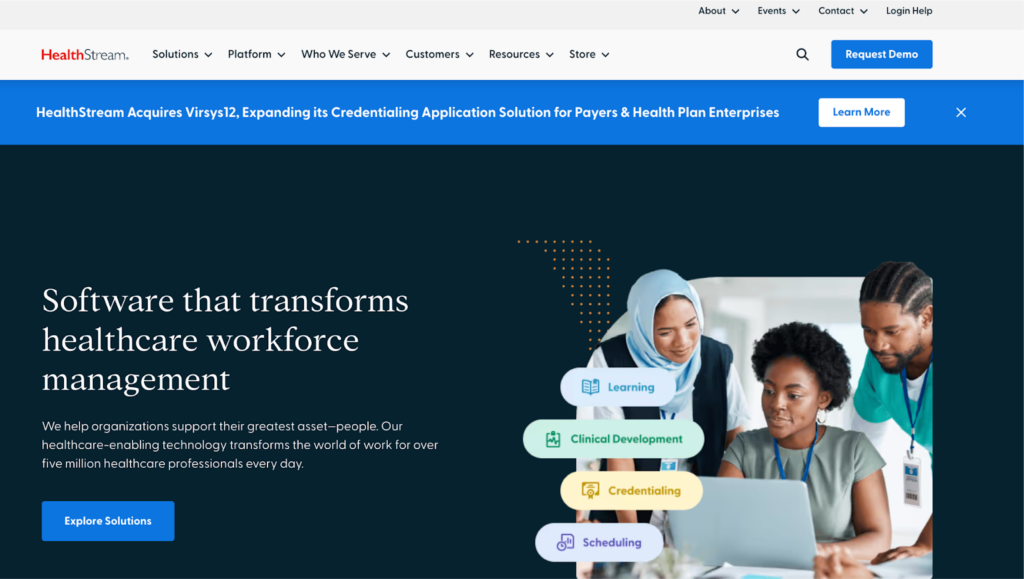
HealthStream is a household name in healthcare education. Its compliance solutions, like ComplyQ and SafetyQ, are deeply integrated within its training ecosystem. This makes HealthStream well-suited for organizations where staff competency, safety training, and regulatory compliance are closely connected. The platform turns compliance requirements into a trackable component of healthcare staff development and evaluation. It’s a natural fit for hospitals and health systems that already use or are looking for a unified platform for staff development and compliance.
Key Features
- A massive library of accredited healthcare compliance courses
- Tools for tracking licenses, competencies, and credentials
- Incident and safety event reporting (SafetyQ)
- Environmental rounding and audit management
- Compliance with OSHA, HIPAA, and other agency requirements
Pros and Cons
| Pros | Cons |
| Strong integration between training and compliance | Limited focus on workforce training and development |
| Large course library |
Client Testimonial
A HealthStream user, an Instructional Designer working in the Health, Wellness and Fitness industry, shared on Capterra:
“HealthStream has a huge amount of features and content targeted specifically for healthcare organizations, which makes their system hard to beat in this industry. BLS/ACLS renewal, other patient safety and clinical content, checklists for skills and equipment check-offs, live class registration management – there is a lot you can do.”
Why Choose This Software
HealthStream is the optimal fit for healthcare organizations that need to centralize workforce development. Choose this software if your main goal is ensuring that staff are appropriately trained, credentialed, and compliant.
3. MedTrainer – Best for Bundling Compliance, Credentialing, and Learning Management

MedTrainer lives up to its “all-in-one” promise by bundling compliance, credentialing, and learning management into a single platform. It’s designed to eliminate the need for multiple disparate systems. Such consolidation saves administrative time and reduces the risk of errors that occur when juggling multiple logins and databases. This approach is efficient for ambulatory surgery centers, medical groups, and community hospitals that want to consolidate their software vendors and streamline their operations without compromising functionality.
Key Features
- Unified system for policies, procedures, and incident reporting
- Full-range credentialing and provider enrollment tracking
- Healthcare-specific training courses and competency management
- Automated license and certificate tracking
- Tools for managing OSHA, HIPAA, and infection control compliance
Pros and Cons
| Pros | Cons |
| Excellent integration of core functions | May not have the same depth of enterprise GRC features as some specialized platforms |
| Exceptionally user-friendly interface |
Client Testimonial
A MedTrainer client, an office administrator at a small healthcare business, shared on G2:
“I love that I can assign my staff education that they need to complete for compliance, and I love that I can also assign them policies that need to be reviewed and signed on a yearly basis. It takes the hassle out of having to track down people to get them to sign a paper copy. We also use it to track our expiration dates on medications and supplies, which it isn’t intended for, but it works for us and allows us to save on having another program to track those things.”
Why Choose This Software
MedTrainer is the ideal solution for organizations that require integrating multiple tools into a single platform. Consider this software if you need to replace multiple systems for learning, compliance, and credentialing with one efficient platform.
4. SafetyCulture – Best for Frontline Operational Compliance & Audits
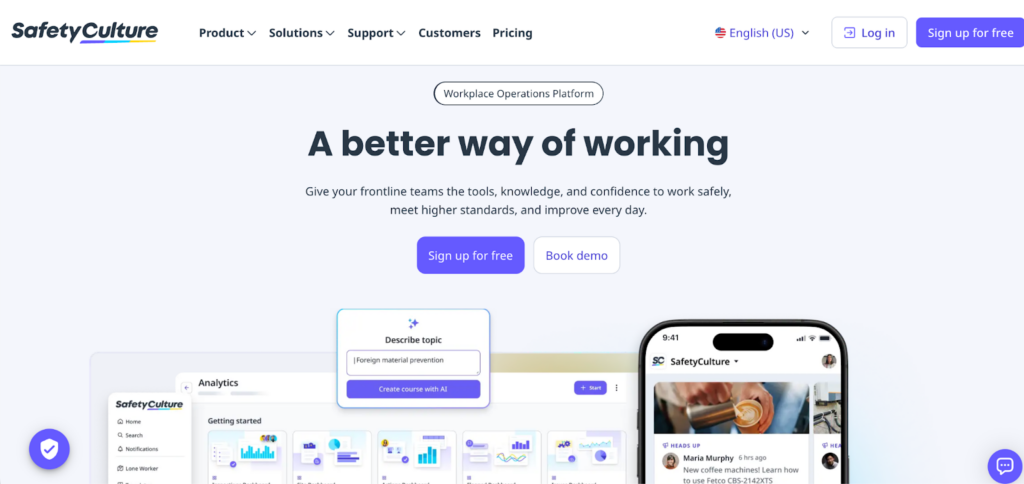
SafetyCulture (formerly iAuditor) has grown from a basic checklist app into a comprehensive mobile-first operations platform. It allows teams to perform safety inspections, manage assets, and report issues instantly from their phones. While it serves multiple industries, it does have a dedicated healthcare module. It is effective at replacing paper systems and providing immediate oversight of operational safety across multiple sites. Plus, the platform promotes a positive safety culture by enabling all staff to report errors and unsafe conditions without fear of blame.
Key Features
- Customizable digital checklists and inspection forms for audits and rounds
- Real-time issue and incident reporting with photo and video documentation
- Task assignment and follow-up tracking to ensure corrective actions are completed
- Auto-generated reports and analytics to track trends and performance
- Mobile access with offline functionality for use in areas with poor connectivity
Pros and Cons
| Pros | Cons |
| Highly intuitive and user-friendly mobile app | Pricing can become expensive as you scale and add more users and features |
| Excellent for streamlining compliance management and audits across multiple sites | Limited advanced customization for complex operations |
| Powerful real-time reporting and analytics for data-driven decision-making |
Client Testimonial
A SafetyCulture user, an engineer at a research firm, shared on Capterra:
“After implementing SafetyCulture, it took very little time for me to be convinced that it is the most reliable and productive tool for maintaining work safety. From running smooth inspection operations to monitoring workplace assets in real-time, SafetyCulture makes it easy to keep everyone and everything compliant with all work safety regulations and measures.”
Why Choose This Software
Opt for SafetyCulture if your goal is to get out of the paper chase and empower your frontline teams with a practical, mobile tool. It’s ideal for digitizing inspections, environmental rounds, and incident reporting to create a visible and accountable safety culture.
5. Sprinto – Best for Cloud-based Healthcare Organizations

Sprinto is a cloud-native, AI-powered security and compliance platform. It’s not exclusively for healthcare, but it is HIPAA-ready and is proven to help tech-focused health companies automate their compliance programs. The platform’s core strength lies in its deep automation. It monitors your cloud environment and automatically collects audit evidence from various systems. This approach is designed to move companies beyond point-in-time audits to a state of continuous compliance, making it a strong fit for digital health startups, SaaS providers, and other cloud-first healthcare technology organizations.
Key Features
- Automated evidence collection from 250+ cloud services
- Support for 200+ compliance frameworks, including HIPAA, SOC 2, ISO 27001, and GDPR
- Role-based task management that flags and routes issues to the right owners
- Real-time visibility into compliance posture with alerts for pending tasks
- Capability for doing audits directly through the platform
Pros and Cons
| Pros | Cons |
| Extensive automation | The product evolves quickly, and occasional updates require teams to adjust to interface or feature changes |
| Vast library of native integrations that connect easily with a modern tech stack | |
| High-quality, responsive customer support and expert guidance |
Client Testimonial
A Sprinto user, a Governance, Risk, and Compliance officer at a medical lab, shares on the Sprinto website:
“Choosing Sprinto for our security and certifications was a no-brainer. It can handle multiple standards at once and map requirements across the board on its own. The dashboard clearly showed what checks are passing and what needs attention. It identifies issues and shows the impacted certificate.”.
Why Choose This Software
Sprinto is a good option for companies that want to maintain audit readiness efficiently, without the need for time-consuming manual work. Choose this software if you are a cloud-based organization looking to automate compliance processes.
6. PRIME® by ATLAS Systems – Best for Large, Highly Complex Networks

This AI-powered solution is specifically designed for a key aspect of the healthcare ecosystem: managing provider data for health plans and health systems. It addresses the critical issue of maintaining accurate provider directories, which is crucial for ensuring timely reimbursements, meeting stringent CMS requirements, and avoiding audit failures. The system automates the tracking of key compliance metrics, including outreach attempts and attestation dates, to create a transparent audit trail. It was recognized as the “Best Provider Data Management Platform” in the 2025 MedTech Breakthrough Awards.
Key Features
- Provider data management and validation for increased accuracy
- Mock CMS and state audit simulations to proactively identify and fix data risks
- Automated provider directory fulfillment for print-ready, ADA-compliant PDFs meeting all CMS mandates
- Appointment wait time compliance using secret shopper surveys
- A provider self-service portal that lets clinicians update their own information
Pros and Cons
| Pros | Cons |
| Specifically built for the unique challenges of healthcare provider data and compliance | Pricing can become expensive as you scale and add more users and features |
| The deep specialization in provider data may be more than needed for organizations looking for a general compliance tool |
Client Testimonial
A PRIME® user, a Senior Manager of Business Intelligence, shared on G2:
“The best thing about Atlas is the diversity of skill sets among the team. No matter what’s going on, Atlas has someone to help.”
Why Choose This Software
PRIME® is best for large, complex networks. Choose this platform if your core compliance challenge revolves around provider data integrity and meeting CMS directory and audit requirements.
7. FlowForma – Best for Complex Processes with a No-code Platform
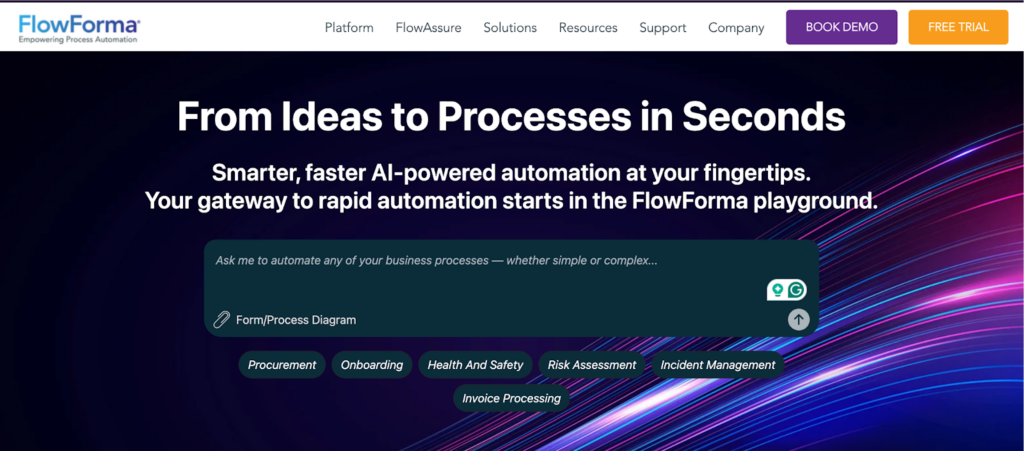
FlowForma is a no-code business process automation platform that stands out for its ability to let compliance officers manage their own digital workflows without relying on IT departments. Its AI Copilot feature can instantly generate workflow prototypes from simple text descriptions, speeding up the automation of clinical and administrative processes. FlowForma’s strong integration with Microsoft 365 makes it particularly appealing to healthcare organizations already in the Microsoft ecosystem that want to digitize paper-based processes like incident reporting, patient onboarding, and contract management.
Key Features
- No-code digital forms with an intuitive drag-and-drop interface for consistent data capture
- AI Copilot workflow generation to create compliance processes from simple, plain-language descriptions
- Easy Microsoft 365 integration connecting directly with SharePoint, Teams, and Outlook
- Real-time compliance tracking for instant visibility into workflow status
- Automated generation of compliant forms and audit logs directly from captured data
Pros and Cons
| Pros | Cons |
| No-code design means those who know the processes best can build and manage them | Requires a Microsoft 365 environment to function optimally |
| Automatically logs every action for accountability, simplifying audits |
Client Testimonial
A FlowForma user, a Business Analyst working in the Education Manager sector, shared on Capterra:
“FlowForma has enabled an organisation previously highly dependant on manual paper based process to embrace digital change. We have so far implemented 7 key electronic business processes, saving the organisation over 5000 admin hours annually”.
Why Choose This Software
Choose FlowForma if you need to quickly digitize manual, paper-heavy compliance processes and empower your non-technical staff to build and maintain their own workflows. It’s ideal for creating a visible and accountable operational culture.
8. Compliancy Group – Best for HIPAA Compliance Simplification
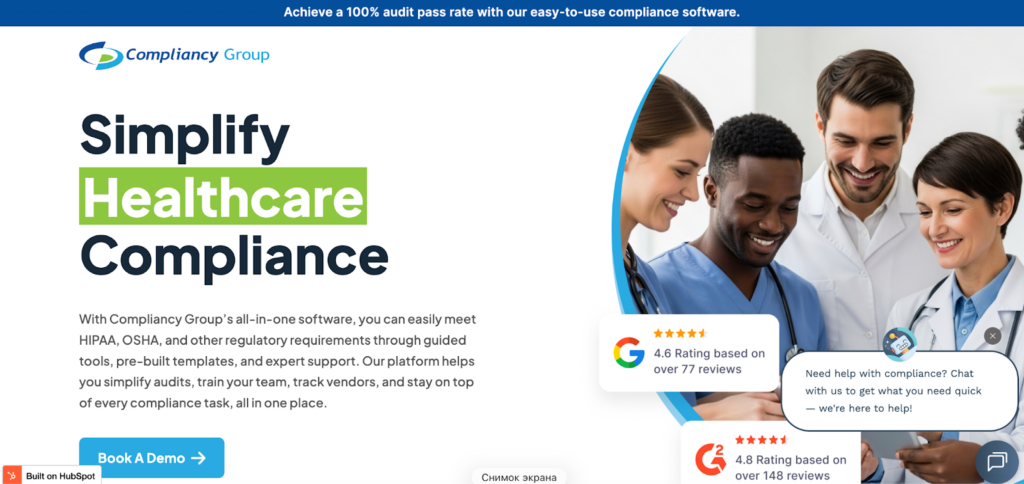
Compliancy Group offers “The Guard,” a software solution created specifically to simplify HIPAA compliance. The platform is built for healthcare providers and business associates who may find the complex HIPAA rules overwhelming. It stands out by combining software with direct access to compliance coaches, guiding users through every step and making the process more manageable, especially for organizations without dedicated compliance staff. The software also includes a simplified risk assessment that automatically identifies gaps and suggests actions.
Key Features
- A compliance dashboard with a real-time snapshot of all tasks, training progress, and remediation efforts
- Simplified risk assessments with yes/no questionnaires to automatically identify gaps and create corrective plans
- Over 90 specialized courses covering HIPAA, OSHA, and cybersecurity
- Access to compliance coaches for personalized guidance
- Streamlined documentation through personalized, regulation-ready templates and policies
Pros and Cons
| Pros | Cons |
| The combination of software and live coach support is a significant differentiator | The platform is centered on U.S. regulations like HIPAA and does not prominently support international frameworks like GDPR |
| Is easy to navigate, even for those who aren’t tech-savvy |
Client Testimonial
A Compliancy Group user, an owner of an optometry clinic, shared on the Compliancy Group website:
“Unbelievably thorough approach to the minefield of HIPAA regulations that no provider can possibly be adequately aware of. I have been well educated, and now well covered, in just a few weeks. Do yourself this favor.”
Why Choose This Software
Compliancy Group is an excellent fit for practices that want the confidence of expert support and a structured, easy-to-follow process to achieve and maintain compliance. Choose this software if your primary need is straightforward, guided HIPAA compliance.
9. VComply – Best for Policy Management
This cloud-based GRC platform tackles compliance head-on with a strong focus on automation and AI. It’s built to replace the chaos of spreadsheets with a structured system that assigns tasks, tracks progress, and keeps evidence organized. While it serves multiple industries, its recent HIPAA certification and healthcare-ready templates make it a strong option for health tech companies and healthcare providers looking for a modern, automated approach. The platform is particularly effective for scaling from smaller clinics to larger enterprises, offering the kind of flexibility that growing organizations need.
Key Features
- AI-powered assistant summarizing documents and answering questions in real-time
- Automated evidence collection and audit trail creation
- Centralized policy management with workflows for review, approval, and certification
- Real-time compliance tracking across frameworks like HIPAA and OSHA
- Anonymous incident reporting hotline
Pros and Cons
| Pros | Cons |
| Strong automation and AI features that reduce manual workload | Not a healthcare-native platform, though it has built specific healthcare compliance features |
| Highly flexible and scalable for organizations of various sizes |
Client Testimonial
A VComply user, a Chief Information Officer at a mid-size firm, shared on G2:
“VCOMPLY was very easy to stand up. The modules are intuitive and easy to understand. Policies can be accessed, attested to, and connected to compliance responsibilities. VComply is scalable and flexible. It provides a single source of truth for policies, tracks versions, and revisions. Customer support has been great.”
Why Choose This Software
Choose VComply if your priority is to automate the heavy lifting of compliance. It’s ideal for organizations tired of manual tracking and that want a modern, AI-enhanced platform to manage policies, risks, and incidents with efficiency.
10. Healthicity – Best for Auditing
Healthicity offers a range of tools designed specifically for healthcare, with a clear emphasis on making compliance and auditing simpler. Their flagship Compliance Manager software provides a customizable workspace to manage the entire program in one place. It’s a deeply healthcare-focused solution that feels like it was built by people who understand the daily grind of a compliance officer, which includes tracking incidents, managing third-party risk, and preparing for that sudden audit notification . The goal is to give your staff a sense of control and preparedness, rather than constantly reacting to problems.
Key Features
- AI-powered hotline for SmartLine incident reporting
- Exclusion monitoring to screen staff and vendors against OIG lists
- Built-in HIPAA security risk assessment management
- Flexible audit management tools to help compliance officers manage internal and external audits
- Third-party management module to identify business associates and assess risk levels
Pros and Cons
| Pros | Cons |
| Designed specifically for healthcare workflows and jargon | The user base cap on lower-tiered plans may not suit rapidly scaling organizations |
| User-friendly tools for both compliance and auditing | May offer more auditing depth than smaller practices need |
Client Testimonial
A Healthicity user, a Human Resource Generalist at a large enterprise, shared on G2:
“I use it daily for almost 2,000 employees! It is user friendly and I am able to onboard and offboard seamlessly in Healthicty!”.
Why Choose This Software
Healthicity is a solid fit for organizations that need to tightly control third-party vendor risk and want modern tools like an AI hotline. Go with this software if you want a healthcare-native platform that excels at both compliance management and auditing.
11. Healthcare Compliance Pros – Best for Managing Multiple Practices
Healthcare Compliance Pros (HCP) complements its software with direct, hands-on support from a dedicated team of compliance experts. This is a service first, technology platform second. They provide an all-in-one system that covers HIPAA, OSHA, and corporate compliance, which is ideal for smaller to mid-sized practices that may not have a dedicated compliance officer on staff. The feeling of having a consultant built into the software is a key part of their value proposition. This approach effectively acts as an outsourced compliance department, saving both time and resources.
Key Features
- Dedicated compliance support team assigned to each client for personalized guidance
- Audit support from experts for HIPAA, OSHA, and corporate compliance audits
- Extensive learning management system with over 130 courses
- Custom policy and procedure management updated for regulatory changes, with employee acknowledgment tracking
- Breach management services and security risk analysis
Pros and Cons
| Pros | Cons |
| Expert guidance and audit support | The platform may feel less customizable compared to more enterprise-focused GRC tools |
| All-in-one suite to manage policies, training, and incidents, reducing vendor clutter |
Client Testimonial
An HCP user, an executive at an orthopaedics facility, shared on the HCP website:
“My practice has been partnered with HCP now for over 3 years and it has been one of the best decisions that we made! They are so responsive and helpful anytime that I need guidance on a topic or even education. Knowing that I have a team of trained professionals behind me has really alleviated a lot of stress and worry when it comes to the ever-changing world of Compliance in the healthcare field.”
Why Choose This Software
Healthcare Compliance Pros is the best fit for practices that need to offload the burden of compliance management and want a true partner to help navigate audits. Choose it if you want the confidence of expert support bundled with your software.
How We Selected the Best Healthcare Compliance Software
We evaluated healthcare compliance platforms using a framework focused on what healthcare organizations actually need. Each solution was measured against these criteria:
- Regulatory Coverage: We selected solutions that support HIPAA, OSHA, and HITECH requirements as a baseline. We prioritized platforms that offer additional framework support, including NIST cybersecurity standards and GDPR compliance, for organizations with global operations.
- Core Features: We assessed how well platforms connect risk assessment, policy management, incident tracking, and staff training into unified workflows. The most effective tools automate compliance processes rather than simply documenting them.
- Healthcare-Specific Design: We favored platforms built specifically for healthcare providers over generic compliance tools. Healthcare-native solutions understand clinical workflows, patient safety reporting, and the management of PHI.
- Enterprise Scalability: Solutions were tested for their ability to scale from single clinics to multi-hospital systems. We evaluated their capacity for centralized oversight, multi-facility management, and handling increased compliance complexity as organizations grow.
- User Experience: Intuitive dashboards and minimal IT dependency were essential factors. We prioritized systems that compliance teams can operate effectively without constant technical support.
- Real-World Performance: Verified customer reviews, case studies, and industry recognition played a significant role in our assessment. We looked for evidence of successful implementations in a range of organization types (hospitals, clinics, health systems, etc.).
- Implementation Support: We evaluated onboarding processes, training resources, and the responsiveness of customer support. A smooth implementation often determines long-term success more than feature capabilities alone.
This methodology ensured we identified solutions that deliver practical compliance management for healthcare organizations.
Why Do Companies Need Healthcare Compliance Software?
Beyond helping you avoid penalties, the best healthcare compliance platforms turn compliance from a reactive cost center into a proactive function that protects your organization and the patients you serve. Here’s how the right compliance software changes your risk management:
- Reduces Legal and Financial Risk: Automated tracking systems monitor regulatory deadlines and policy updates in real-time. This prevents costly oversights, such as missing a HIPAA Security Rule update or an OSHA reporting deadline, which could result in penalties exceeding six figures.
- Cuts Administrative Work: Your team spends a significant amount of time chasing policy acknowledgments, compiling training records, and preparing for audits. Compliance software automates these repetitive tasks, freeing your staff to focus on higher-priority work.
- Improves Data Security: Centralized systems offer controlled access to sensitive information, featuring built-in encryption and audit trails. This creates multiple layers of protection against data breaches that could compromise patient information, triggering mandatory breach reporting requirements.
- Strengthens Patient Safety: When incident reports get lost in email inboxes and staff certifications expire unnoticed, patient safety suffers. Compliance platforms ensure consistent tracking of safety incidents, credential expirations, and competency requirements.
- Simplifies Audit Preparation: Proper compliance software organizes every policy, training record, risk assessment, and incident report in one searchable system. This transforms the audit process from a stressful scramble into a manageable, organized exercise.
FAQs on Best Healthcare Compliance Software
What is healthcare compliance software?
It’s a specialized digital platform that helps healthcare organizations comply with laws and regulations. Instead of using spreadsheets and paper files, it automates and centralizes tasks like policy management, staff training, risk assessments, and incident reporting.
Who can benefit from healthcare compliance software?
Virtually any organization handling protected health information (PHI) can benefit. This includes hospitals, medical practices of all sizes, dental offices, clinics, nursing homes, and even business associates like billing companies and IT vendors.
Is healthcare compliance software suitable for small practices?
Absolutely. Many platforms are designed with small practices in mind, offering scalable, affordable plans that address core needs without overwhelming your team. These solutions are crucial for small teams that lack a dedicated compliance officer, as they provide the structure and guidance necessary to manage HIPAA, OSHA, and other regulations efficiently. Using dedicated software is often more cost-effective than risking the penalties and operational disruptions that come from manual errors.
How do I select the most suitable healthcare compliance software for my organization?
Start by pinpointing your most pressing pain points. Is it staff training, policy management, or preparing for an audit? Then, match those needs to a platform’s strengths. You must also honestly assess your organization’s size and growth potential. A tool designed for a large hospital may overwhelm a small clinic, and vice versa. Finally, take advantage of free demos. They are the best way to see if the software’s workflow and interface are a natural fit for your team’s daily operations.
Taking the Next Step
Now that you’ve reviewed the leading healthcare compliance platforms, it’s time to choose the one that fits your needs.
Begin by writing down your most significant compliance issues. Is your team spending too much time manually tracking policies? Are your staff training records scattered across different systems? You may need better tools for vendor risk assessments.
Once you’ve identified your specific needs, bring together a small team of people who will actually use the platform: compliance officers, IT staff, department managers, and training coordinators. Their feedback during demos will help you see how the software works in real situations.
Next, start engaging directly with platforms that align with your specific needs. Take advantage of free demos with top contenders like ComplyAssistant, HealthStream, and MedTrainer to experience their workflows firsthand.
Ultimately, investing in the proper compliance infrastructure represents a commitment to both regulatory excellence and patient safety. By implementing the right system now, you’re not just preparing for audits. You’re building a stronger, more trustworthy healthcare organization.

